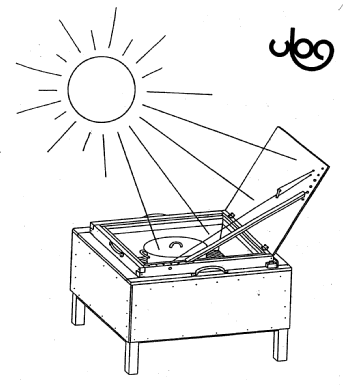
SOLAR-OVEN ULOG
FOR COOKING AND BAKING
IN TROPICAL AREAS
SOLAR-OVEN ULOG
FOR COOKING AND BAKING
IN TROPICAL AREAS
Self-Construction Directions
SOLAR ENERGY FOR ALL!
This is the motto of the group ULOG, a loose alliance of active people in Switzerland and Germany who stands for the idea to make the energy of the sun available for the world population equally in all countries. Wood, the most common energy-source for cooking and baking, especially in the southern countries, is getting more and more scarce in many places. This leads to soil erosion and desertification of vast areas, which is again linked to global social problems like hunger and migration. Solar-cookers can help to preserve valuable trees and also help create awareness for global problems in the northern countries.
The solar-oven is a useful and well proved alternative to burning wood. It is an extremely simple cooker which relies exclusively on the direct radiation of the sun. Most dishes can be cooked in it, and this without additional work, quite the contrary! Cooking with the solar-oven does not need supervision because stirring the pan is not necessary. The solar-oven functions according to the greenhouse effect, i.e. the light rays from the sun (not heat-rays) penetrate the window and are absorbed by the dark surfaces in the inside and so changed into heat. As the inside of the oven is airtight and as glass is largely impermeable to heat radiation, the temperature inside rises until the losses by heat-radiation are equal to the energy that falls in. To reduce the losses of heat the window is double glassed and the inside of the oven is insulated all-round. Thereby temperatures above 100°C are obtained, enough for cooking and even for baking.
As only little heat can be stored, we need direct sun radiation during most of the cooking time. The following construction manual should enable even an amateur to build a solid and long-lasting solar cooker. The necessary material is easy to get and not expensive.
The basic measurements may be adapted according to given facts (e.g. different size of the glass, longer legs). You can get construction manuals for other models from group ULOG in Basel/Switzerland. Construction kits and ready-made solar-ovens of all models can be delivered.
In addition to the solar-oven a construction manual on how to build solar-dryers for the conservation of food and for a simple solar water-heaters is available, too. Solar Community Kitchens as developed by W.Scheffler serve for big communities like schools, hospitals and monasteries . They suit for cooking and baking for several hundred people. We are glad to give more information on request. Members of our group also travel abroad to help initialise solar-cooker projects. Local artisans are instructed and trained in construction and use of the cookers. Dissemination-strategies are developed together.
Financial support might come from Globosol (a Swiss organisation for the promotion of solar cooking) or other associations.
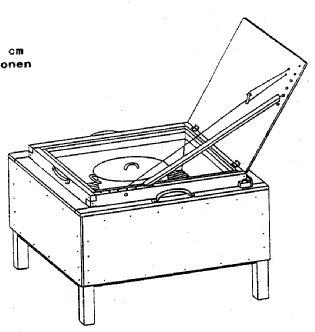
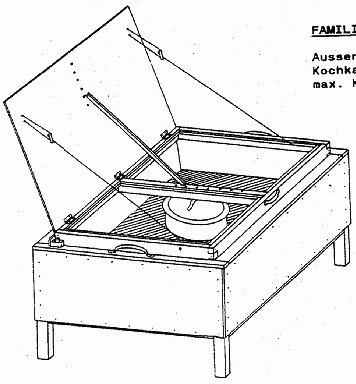
List of parts for STANDARD- "S" AND FAMILY-SIZE "F" Solar Cooker
|
item |
number S F |
description |
dimensions (cm) |
material |
|
1 |
2 4 4 |
sheet of glass |
50 x 50 x 0,3 |
window glass |
|
2 |
4 2 |
frame for glass |
54,9 x 6 x 2,2 |
wood |
|
3 |
- 2 |
frame for glass |
107,6 x 6 x 2,2 |
wood |
|
4 |
- 1 |
cross bar |
50,5 x 6 x 2,2 |
wood |
|
5 |
8 16 |
retaining fillet |
49,5 x 1,4 x 1 |
wood |
|
6 |
4 8 |
spacer fillet |
49,5 x 2,4 x 1 |
wood |
|
7 |
1 - |
reflector lid |
55 x 55 x 0,5 |
plywood bakelised |
|
8 |
- 1 |
reflector lid |
108 x 55 x 0,5 |
plywood bakelised |
|
9 |
1 - |
reflector foil |
55 x 55 x 0,01 |
alufoil, tinfoil |
|
10 |
- 1 |
reflector foil |
108 x 55 x 0,01 |
alufoil, tinfoil |
|
11 |
2 3 |
hinge |
3 x 3 |
steel, galvanized |
|
12 |
1 1 |
prop for reflector |
50 x 1,5 x 1,5 |
wood |
|
13 |
1 2 |
cord |
Æ 0,3 x 100 |
nylon |
|
14 |
1 2 |
cord tightener |
3,5 x 1,5 x 0,5 |
plywood bakelised |
|
15 |
2 2 |
window holding ledge |
25 x 2,5 x 1 |
hardwood |
|
16 |
2 2 |
buffer block |
5 x 2 x 2 |
hardwood |
|
17 |
2 2 |
revetment |
67,5 x 6,3 x 1,5 |
wood |
|
18 |
2 - |
revetment |
55 x 6,3 x 1,5 |
wood |
|
19 |
- 2 |
revetment |
107,8 x 6,3 x 1,5 |
wood |
|
20 |
3 3 |
handle |
16,5 |
steel chromium plated |
|
21 |
1 - |
stove bottom (trough) |
78 x 78 x 0,03 |
offset plate, alu sh. |
|
22 |
- 1 |
stove bottom (trough) |
131 x 78 x 0,03 |
offset plate, alu sh. |
|
23 |
2 2 |
frame f. stove bottom |
50,5 x 8 x 2,2 |
wood |
|
24 |
2 - |
frame f. stove bottom |
66,5 x 8 x 2,2 |
wood |
|
25 |
- 2 |
frame f. stove bottom |
119,5 x 8 x 2,2 |
wood |
|
26 |
4 4 |
frame joint |
7,5 x 15 x 0,8 |
plywood |
|
27 |
4 2 |
side wall |
67 x 27 x 0,5 |
plywood |
|
28 |
- 2 |
side wall |
120 x 27 x 0,5 |
plywood |
|
29 |
4 4 |
leg |
40 x 4 x 4 |
wood |
|
30 |
4 2 |
reinforcing strip |
58,5 x 2,5 x 1,5 |
wood |
|
31 |
- 2 |
reinforcing strip |
111,5 x 2,5 x 1,5 |
wood |
|
32 |
1 - |
floor |
67,5 x 67,5 x 0,5 |
plywood |
|
33 |
- 1 |
floor |
120,5 x 67,5 x 0,5 |
plywood |
|
34 |
30 40 |
wood screw countersunk |
Æ 0,3 x 2 |
steel |
|
35 |
24 48 |
wood screw countersunk |
Æ 0,3 x 2,5 |
steel |
|
36 |
4 4 |
wood screw countersunk |
Æ 0,35 x 2 |
steel |
|
37 |
12 12 |
wood screw countersunk |
Æ 0,35 x 3,5 |
steel |
|
38 |
- 4 |
wood screw countersunk |
Æ 0,35 x 5 |
steel |
|
39 |
4 6 |
button head rivet |
Æ 0,3 x 0,8 |
aluminium |
|
40 |
131 152 |
nail flat-headed |
Æ 0,14 x 2 |
steel |
|
41 |
18 24 |
nail sunk-headed |
Æ 0,14 x 3 |
steel |
|
42 |
14 14 |
nail sunk-headed |
Æ 0,2 x 5 |
steel |
|
43 |
|
glue for wood |
|
|
|
44 |
|
paint |
|
black, mat, dull |
|
45 |
|
insulation material |
8 cm thick |
mineral wool mats |
|
46 |
|
weather protection |
|
e.g. linseed-oil |
Variations for some parts of the list
.2. Window:
3. Reflector:
4. Frame for stove bottom:
5. Stove body:
6. Stove bottom (trough):
7. Insulation:
8. Window lining:
9. Final works:
Drawings
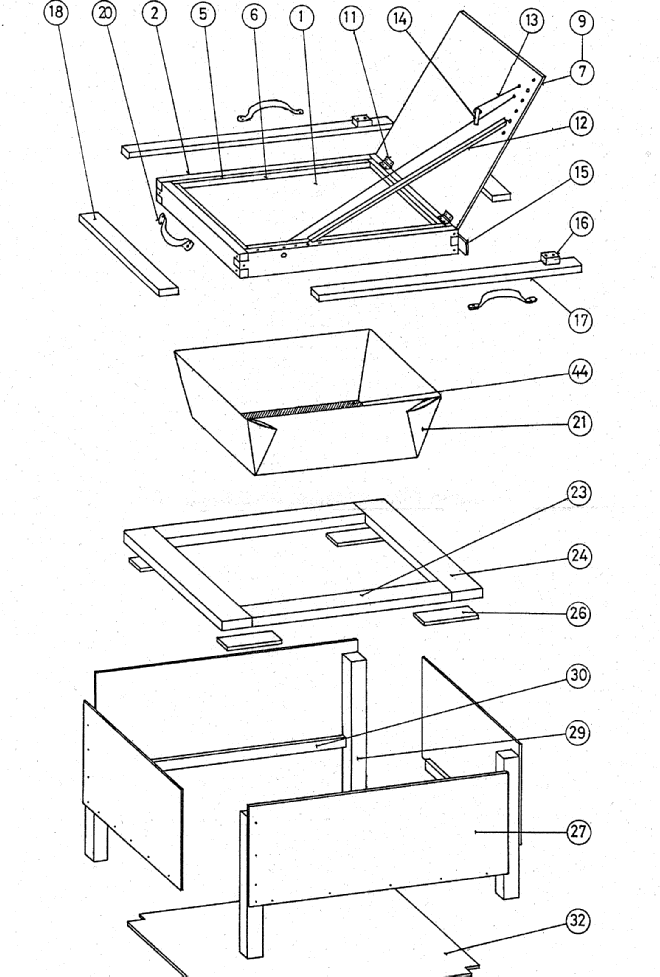
Fig. 4 Explosion schema


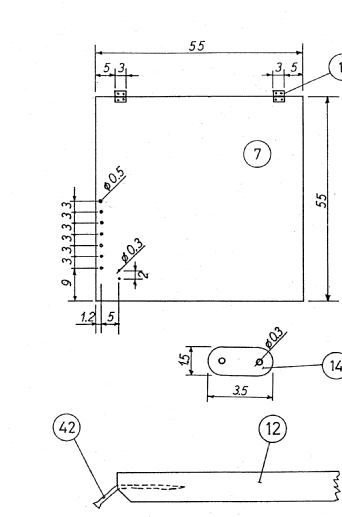
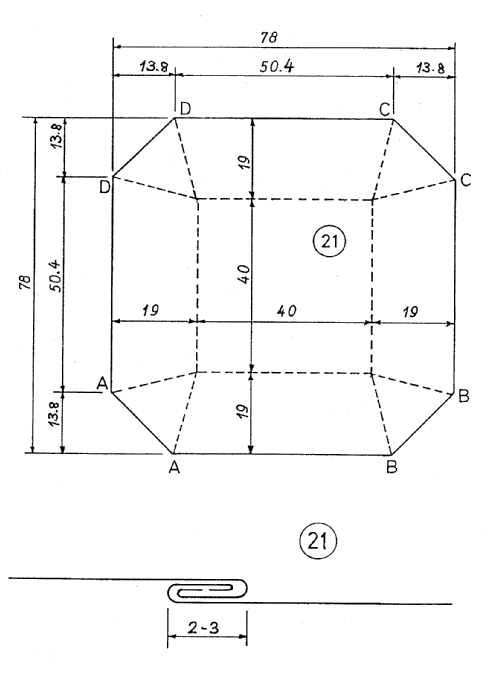
Some important tips for the use of the solar-cooker/oven (SO)